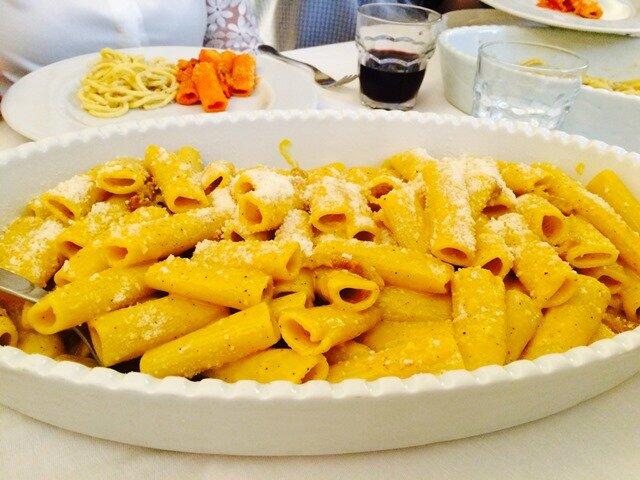People from all over the world come to Italy to sit at Italian tables and to eat Italian food. Sauntering in to a local trattoria can be intimidating if you are traveling without a human version of Google Translate by your side. Here are my language and general etiquette tips to making your restaurant experience seamless and social…
Making an Entrance
Start with a greeting. Italians always enter a room with a formal salutation; usually Buongiorno (before 3 pm) or Buonasera (after 3 pm). An easier choice and one that is always appropriate is: Salve. Morning noon or night, this will let the staff know that you are savvy and smart enough not to open with Ciao. Ciao is never used with people you are just meeting!
From there, you can move onto: Possiamo avere un tavolo? meaning “Can we have a table?”

Ordering Food and Drinks
Chances are, the first question your waiter or waitress will ask is if they can bring you water.
Gassata o naturale? meaning “With bubbles or without?”. A great response is Una e una (one of each). And always ask for the wine list: Mi porta la carta dei vini?
Menus are not so difficult for the English-speaking traveler as we often eat Italian food in our respective home countries. The menu in Italy is always divided into: antipasti (appetizers), primi (pasta and soups), secondi (meat and fish), contorni (side dishes) and dolci.
A quick note: You are not obliged to eat every course. Eat what you like when you like. But order your wine only after you’ve chosen your meal.
With that said, the antipasto is usually not to be missed. An array of sumptuous selections are offered in small portions, and usually leave you feeling satiated and happy before your main dish even arrives. You can request: Possiamo avere un antipasto misto? This is a mixed appetizer course with all the best dishes present.
A Quick Lesson in Pasta
On to the pasta course… or the primi piatti. One problem that often arises with my foreign friends comes with the varied choices of pasta. Yes, most of you know spaghetti, fettuccine, penne or tortellini. But Italy has over 235 types of pasta. Below is a list of pastas not to be missed during your time on the peninsula.

TONNARELLI: Tonno in Italian is tuna. These are in fact not little fish but a type of spaghetti that’s square-shaped instead of round. A famous dish made with these is tonnarelli cacio e pepe (with cheese and black pepper).
STROZZAPRETI: This literally translates as “strangles a priest”! This handmade pasta is the length of a thumb, and history says that the clergy loved this type of pasta so much they would choke it down at super-speed. Strozzapreti is made with just flour, salt and water. One famous dish made with it is strozzapreti al sugo di cinghiale (with wild boar sauce).
BUCATINI: This is a tube-like spaghetti with a buco or hole inside that permits the hot water to cook it fast and better. It’s famously paired with tomato sauce and guanciale (a type of cured pork) for the famous dish bucatini all’amatriciana (a traditional Italian pasta sauce based on guanciale, pecorino cheese, and tomato).
MEZZE MANICHE: Translating to “short sleeves”, this is a short pasta characterized by the streaky lines that are important to hold the sauce over the entire surface. The mezze maniche ai frutti di mare (with seafood) is something you should definitely order.
GNOCCHI: The name derives from the Lombard knohha (meaning walnut) and were originally made of flour and water. In Italy, they are made primarily with potatoes. An old saying says giovedì gnocchi indicating that Thursdays are the best day to eat them. You must try gnocchi con ragù (with a meat and tomato-based sauce).
Meat, Fish and Vegetables
If you choose a second dish (and why not? You’re in Italy) without having a pasta dish, you might want to suggest that both the meats and pastas be served together. You can request:
“Può portare tutto insieme?” (Can you bring everything at the same time?)
In my opinion, you can never go wrong with pork (porchetta, salsiccia). Heck it’s Italy… you can never go wrong with fish (baccalà, scampi), chicken (fettina panata) or beef (Fiorentina) either.
If you want vegetables or roast potatoes to accompany your meat or fish, remember that these are mostly not served with the dishes but must be ordered separately as a contorno (side dish).

Dessert and Coffee
For dessert… I say, go for it! Millefoglie or tiramisu’ are never bad choices. But you might want to try torta della nonna or a tartufo (which translates as truffle but is actually a delicious ice cream confection).
After dinner, wash everything down with a coffee. DO NOT ask for a cappuccino. Italians only have this for breakfast, and believe the high milk content slows digestion, while a shot of espresso speeds it up. A nice compromise is to ask for a: caffé macchiato, which is both acceptable and like a tiny cappuccino.
The End of the Meal
Last but by no means least, ASK FOR THE CHECK! It is considered bad form for a waiter to bring a check without the guest first requesting it. I have seen many a tourist scratching their heads and waiting around. So you must say: “Il conto per favore” (the check, please).
And finally, just like your mother taught you, always say thank you and goodbye as you leave: “Grazie e arrivederci.”












